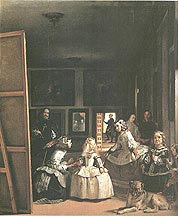

Any discussion of the artist in western art needs to consider Velázquez's famous painting entitled Las Meninas or The Maids of Honor. On the left standing behind a stretched canvas and holding a brush and palette in his hands appears Velázquez. On his tunic appears a red cross that can be identified as the symbol for the Order of Santiago, the Spanish knighthood. In the center is the Princess Maragarita, the daughter of King Philip IV of Spain. The faces of her parents, the king and queen, appear in the mirror on the back wall.

An 18th century description of the painting written by Antonio Palomino has given us the identification of many of the other figures:

Kneeling to the left of Margarita and offering a glass of water to the princess is one of the ladies-in-waiting to the queen. Another lady-in-waiting who was the daughter of a gentleman of the chamber of the king appears to the right of Margarita. Two dwarves appear on the right hand side of the painting. Behind the foreground group appears a Lady of Honor (she wears a nuns habit which was the customary dress of widows at court). She is accompanied by a guardadamas, an escort of the ladies of the Court. Standing in the open door in the back right corner appears José Nieto, Apostentador of the queen.
Studies of the painting have led to the identification of the two paintings hanging above the mirror on the back wall. They are based on oil sketches by Peter Paul Rubens. The one on the left represents Minerva Punishing Arachne:

While the one on the right is a painting of Apollo's Victory over Marsyas:

Both of these classical myths focus on the dangers of rivalling the Gods in the creation of the arts.
While challenging traditional categories of genres of paintings, the painting has been seen in recent critical theory to focus on the status of the artist and the nature of representation.
The seventeenth century continued the distinction between the court artist and the artist that worked independently for the art market. The Dutch artist, Abraham Bosse in the engraving below plays off the status of the noble court artist and the vulgar artist who is represented in an engraving held by an assistant. While the former works in the luxury of the court, the latter toils in the domestic context:

Bosse in this engraving associates the noble artist with the collection of works behind him. The painting below is part of a series of paintings by David Teniers II showing the collection of Archduke Leopold William.

This particular painting was sent by the Archduke to his cousin Philip IV of Spain. The painting serves to document the magnificence of the Archduke's collection, but it also attests to the status of Teniers as his court artist. Teniers' talent as an artist is also manifested by his ability to reproduce the works of the great masters on the walls behind him. Clearly the work of Teniers belongs in this "Hall of Frames." Velázquez is making much the same point by drawing the connection between his work and that of the great Peter Paul Rubens.
The informal nature of Las Meninas that creates the illusion of a slice of everyday life at the court of Spain needs to be considered in the context of the development of court culture in Europe. Throughout the period, increasing emphasis was given to the division between the public and private worlds of the monarch. Only people of the highest status would have been allowed into private world of the King. Since the fourteenth century representations of intimacy displaying the private world of the monarch were ways to accentuate the status of the king and the members of his court. One of the major functions of Velázquez was to paint portraits of Philip IV. These are all formal portraits. I think it is significant that the King and Queen are not directly represented in Las Meninas in an informal way. Even the mirror image on the back wall shows the royal couple in the context of a formal portrait:
